Food Studies and the Gilded Age and Progressive Era
This blog accompanies the special issue of the Journal of the Gilded Age and Progressive Era on Food Studies and the Gilded Age and Progressive Era.
I recently ate a didactic lunch that included a soup made of garden weeds topped with crispy grubs and served with a tiny green crab. All of the ingredients were invasive species. Even as I ate, I admired the way in which the meal mobilized middle class American foodies’ love of novelty to confront ecological problems, a common concern of this group. The chef had entered a long tradition of people who believe that significant social change can be effected through culinary choices. Placing our relationships to both the natural world and our fellow humans in a framework of progress, this discourse can embrace both modernism and nostalgia for its ends.
Since the Progressive Era, Americans with commercial and non-commercial motivations have addressed the middle class with claims that progress can be made through food choices. This may be progress towards a vaguely defined efficient living which has only implied benefits to others or it may be progress towards a more mutually supportive society.
The kind of research and development in commercial food products that began in this era has clearly shaped our world today, not just in the products that we expect to see on supermarket shelves but in our continual anticipation that there will be new products soon and that they will be improvements on the old ones. In some ways, consumer goods companies have made life harder for themselves by teaching us to expect progress. If consumers had been trained to value consistency over novelty, a company like Pepsico would not need to spend so much money developing new flavors of drinks and chips.
Progressive era reformers who advocated for a social order more supportive of human welfare also often identified food as a site for improvement. Using the same kinds of research that could be turned to the manufacturers end, progressive food scientists, nutritionists and dietitians believed that if they could identify the elements of good nutrition, society would find a way to ensure it for all members. This conversation, too, has determined how we think about food as an agent in our lives. For the most part, that search for the holy grail of nutrition has become a personal and commercialized quest. It echoes in food justice movements, too, however, when advocates call for access to what are perceived as the right kinds of foods, rather than just any kind of food at all.
The articles in this special issue of the Journal of the Gilded Age and Progressive Era collectively reveal the overlaps in Progressive Era commercial and non-commercial discourse around food. The writers offer us a new understanding of how Americans of different classes and backgrounds were invited to consume progress in this era, how they, like me with my invasive weed soup, were coaxed to eat their way out of contemporary problems.
Articles in the Special Issue:
- Making Progress in Food, Megan Elias
- Eating Cotton: Cottonseed, Crisco, and Consumer Ignorance, Helen Zoe Veit
- The Progressive Era Body Project: Calorie-Counting and “Disciplining the Stomach” in 1920s America, Chin Jou
- Becoming What You Eat: The New England Kitchen and the Body as a Site of Social Reform, Nicholas J.P. Williams
- “Old Methods Not Up to New Ways”: The Strategic Use of Advertising in the Fight for Pure Food After 1906, Alana Toulin
Main image: Back cover of the Journal of the Gilded Age and Progressive Era, Volume 18, Issue 4.






